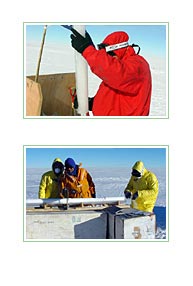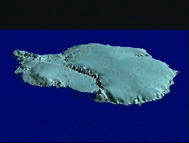
![]()
|
|
| Make your own estimates of sea level rise in this activity! |
 |
 |
 Watch NASA's computer model. (290 kb Quicktime Movie) |
The Antarctic ice cap forms the largest body of fresh water in the world. Ninety percent of our fresh water supply is locked up in 7.25 million cubic miles (30 million cubic kilometers) of glacial ice on the southern continent. If all of this ice were to melt, the height of the earth's oceans--sea level--would rise 160-200 feet (50-60 m). Islands and coastal cities around the world, including Boston, would be completely submerged.
Scientists at NASA have generated a computer model depicting changes in the Antarctic ice sheet since the peak of the last ice age nearly 20,000 years ago. The West Antarctic ice sheet has lost nearly two-thirds of its mass during this period, a volume sufficient to raise sea level 33 feet (10 m).
Glaciologists study the behavior of the ice sheet to understand more about how fast it grows and moves so they might better predict how the ice sheet may respond to climate changes in the future.
![]()
